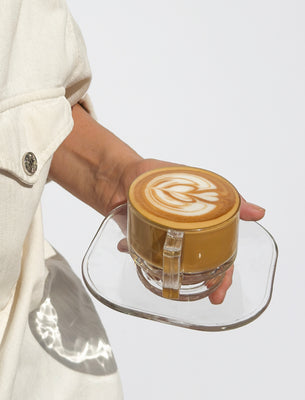If you’ve ever tried to recreate your favourite café drink at home only to end up with something thin, chalky, or wildly different from what you imagined, you’re not alone.
Learning how to make a matcha latte at home seems simple, until it isn’t. The whisking looks easy on TikTok, the color always seems right on Instagram, but somehow the texture never lands the same. That changes today.
In this blog, you’ll learn what actually creates that silky café feel, why your milk choice matters more than the whisk, and how a slow-crafted, fermented oat & koji milk like Koatji transforms your matcha ritual from “fine” to “finally.”
Why Learning How to Make a Matcha Latte at Home Starts With the Milk
You can buy the best ceremonial matcha. You can whisk with perfect form. You can measure it in grams. But if the milk isn’t behaving: if it’s too sweet, too thin, or splits the moment it hits the bowl, your matcha will never taste or feel like the café version.
Most videos teach how to make a matcha latte by obsessing over water temperature or frothing technique, but skip the ingredient that determines foam structure, sweetness, and mouthfeel more than anything else: the milk.
Koatji’s slow-crafted oat & koji blend was developed by chefs and baristas precisely for this very reason. It integrates with matcha instead of fighting against it: no gums, fillers, preservatives, or added sweeteners.
Matcha Basics: Quality, Temperature, and Tools You Actually Need
Before we even get to milk, the foundation has to be right. Here’s the quick, no-nonsense setup:
- Ceremonial-grade matcha means smoother, brighter, and is ideal for lattes.
- Culinary-grade matcha is excellent for baking, but it can often be too bitter for drinking.
Control your water temperature:
- 160-175°F (70-80°C) is ideal
- Anything hotter scorches matcha and turns it bitter
Use all the essential tools like:
- A bamboo whisk (chasen)
- A small bowl or chawan
- A fine sieve
- Optional: handheld frother
Even the best milk can’t fix overheated water or unsifted, clumpy matcha, so these basics matter.
Why Milk Choice Makes or Breaks Your Matcha Latte Experience

Here’s the part no one tells you: the milk is responsible for most of the structure in your latte.
Milk composition, including fat, protein, and natural sugars, impacts:
- Foam stability (microfoam vs big bubbles)
- Sweetness balance
- Texture (silky vs chalky)
- Separation over time
A quick comparison:
- Dairy: Guaranteed to foam reliably, but often overshadows matcha’s delicate, grassy notes.
- Other oat milk variants: Often rely on gums or emulsifiers for foam, which can taste overly sweet or leave a chalky finish.
- Koatji’s Oat & Koji Milk: Slow-crafted fermentation builds natural sweetness and a smooth texture. Always steams and foams like barista milk. Positively supports matcha’s flavour instead of flattening it.
If you’ve been Googling how to make a matcha latte and still aren’t satisfied, the milk is almost always the missing piece.
Inside Koatji’s Oat & Koji Milk: Texture, Fermentation, and Flavor Balance
Koatji starts with two ingredients: organic oats and koji, fermented rice traditionally used in miso, soy sauce, and sake. After nearly 8,000 chef-led R&D trials, the blend is now known for its silky texture and ability to behave like a barista's milk, completely additive-free.
Here’s what fermentation contributes:
- Enzymes gently break down starches into natural sugars
- This creates roundness, balance, and a naturally smooth mouthfeel
- No added sugar, no gums, no fillers required
Koji also naturally contains vitamins B2 and B6, which are involved in energy metabolism and nervous system function.
And this matters deeply for matcha: Fermentation gives Koatji a cohesive, velvety integration with matcha, supporting its umami notes without overwhelming them. It’s an organic oat milk option built to complement subtle flavours rather than mask them.
Step-by-Step: How to Make a Matcha Latte at Home With Koatji
Here is the method that finally works, every time:
- Sift 1-2 teaspoons of matcha into a small bowl.
- Add 1-2 tablespoons of hot (not boiling) water.
- Whisk in quickly, using “W” motions, until a smooth paste forms.
- Add more water (about ¼ cup) to create a concentrated base.
- Heat Koatji in a small pot or steam pitcher.
- Froths to a tight microfoam, with fine bubbles and a glossy texture.
- Pour Koatji over the matcha base slowly to preserve its layers.
- Add optional flavouring (vanilla, a touch of maple).
Visual cues:
- The matcha should be vibrant, not dull.
- Koatji should pour in a smooth, uninterrupted stream.
- The top layer holds a soft sheen of microfoam.
This is an adaptable Koatji recipe for matcha, available in light or rich, sweet or unsweetened varieties. And yes, it really does taste like the café version.
Texture Troubleshooting: Fixing the Most Common At-Home Matcha Latte Mistakes

If something still feels off, here’s your quick diagnostic:
Thin or watery?
- Reduce water.
- Increase milk ratio.
- Use more Koatji for your body.
Gritty or clumpy?
- Sift the matcha.
- Lower water temperature.
- Whisk longer.
Foam disappears too fast?
- Start with cold Koatji before steaming.
- Avoid overheating.
- Froth to smaller bubbles.
Too bitter?
- Use higher-quality matcha.
- Drop the water temperature slightly.
- Add a small amount of natural sweetener if needed.
Koatji solves many of these texture issues by design; its fermentation-driven body and foam stability take a lot of the guesswork out.
Iced, Flavored, and Everyday Variations (Without Losing the Café Texture)
Once you’ve mastered the base method, you can remix endlessly:
- Iced matcha latte: Shake your matcha base with cold Koatji and ice. It remains cohesive with no chalky residue and no separation.
- Vanilla or maple matcha: Add tiny amounts of flavour to preserve matcha’s notes.
- Stronger or lighter versions: Adjust the ratio without losing creaminess or foam.
Everything builds from one solid template. Start a flexible subscription to Koatji’s Barista Oat & Koji Milk so you’re never without the milk that actually works.
Choosing Your Go-To Milk and Your Matcha Ritual
Here’s a simple way to make a choice. If you want clean ingredients and barista-level foam, choose Koatji. If ultra-low cost is your priority, generic, shelf-stable oat milk variants will work, but expect trade-offs. If you prefer something dairy-like, dairy still provides strong foam but may overshadow matcha’s delicate profile.
Ultimately, mastering how to make a matcha latte is half technique and half choosing a milk that's built for the job. Your matcha is a ritual: calm, intentional, grounding. Your milk should feel just as considered.
Explore Koatji’s Barista Oat & Koji Milk, try it in your next matcha ritual, and explore matcha recipes.




